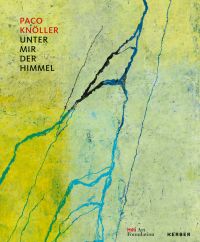
Paco Knöller – Hilti Art Foundation, Liechtenstein
17 Nov — 27 Oct 2024
The Hilti Art Foundation once again presents a selection of art exclusively from its own collection. The Whole Palette showcases well-known works of great beauty by such artists as Pablo Picasso, Max Beckmann, Ferdinand Hodler, Piet Mondrian and Verena Loewensberg, as well as superb new acquisitions by Edvard Munch, Max Ernst, Sophie Taeuber-Arp and Callum Innes. The exhibit also presents new works of sculpture, collage, photography and prints by artists such as Jean Tinguely, Henri Matisse, Thomas Struth and Carol Wyss. A surprising variety of genres and styles as well as motifs, materials and colours will be on view. The exhibition also offers an insight into the current status of the collection.
Paco Knöller’s primary means of artistic expression is the drawn line, created using a pencil, coloured pencil, ballpoint pen, oil pastels or a knife, and, as his support, paper or wood. In his oil pastels on wood, the artist completely immerses himself in the colours before drawing a single line. The colours create the fertile field in and on which the lines take shape. He starts by “sealing” his support with black lacquer, which serves as a primer for subsequent layers, now in colour. The artist applies his intensely coloured oil pastels with a stick or, if they are loosely pigmented, with a spatula and the heel of his hand. The breathing permeability of the painting reveals what lies beneath the top layers. In contrast to paper, wood is hard and resistant so that the form-giving lines are not simply “added” to the coloured oil pastels, but rather “engraved” with a knife, thus “subtracting” pigment at times to reveal the layers of coloured lacquer underneath. To do so, Knöller slides the blade of the knife across the paint. This does not produce a sharp cut, but rather a more or less broad and splintered trace of paint on the picture plane. The result is both a structural and aesthetic symbiosis of line, paint and surface. The Thinking Reed is a series of works that visualizes a poem of the same name by the American artist Agnes Martin and also references Blaise Pascal. In Pensées (VI, 347, publ. 1670), Pascal writes: “Man is only a reed, the weakest in nature, but he is a thinking reed.” Knöller creates a weave of delicate vegetable shapes, in which we can identify stalks, leaves and blossoms unfolding on a yellow, green or black ground. However, his primary concern is not the profound impact on Pascal of humanity’s fragility in the face of the destructive forces of nature and the immeasurable immensity of the universe. Rather, his series draws our attention to the reed itself and ultimately to all plant life as a “thinking” and interconnected organism that has an intimate relationship with its environment; an organism that not only created human life but also serves as an indispensable foundation thereof.
Please log-in or create an account to see your recent items.